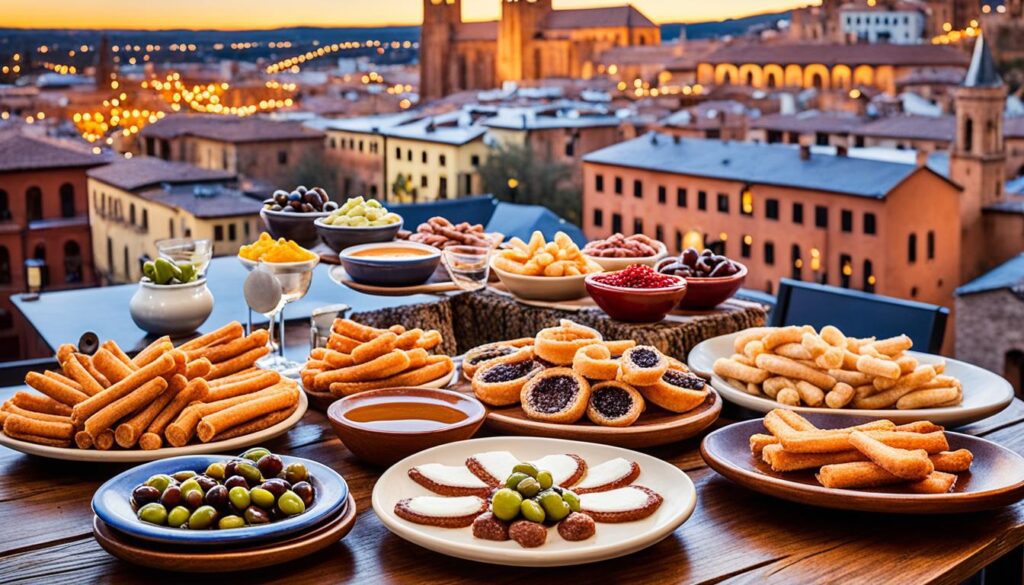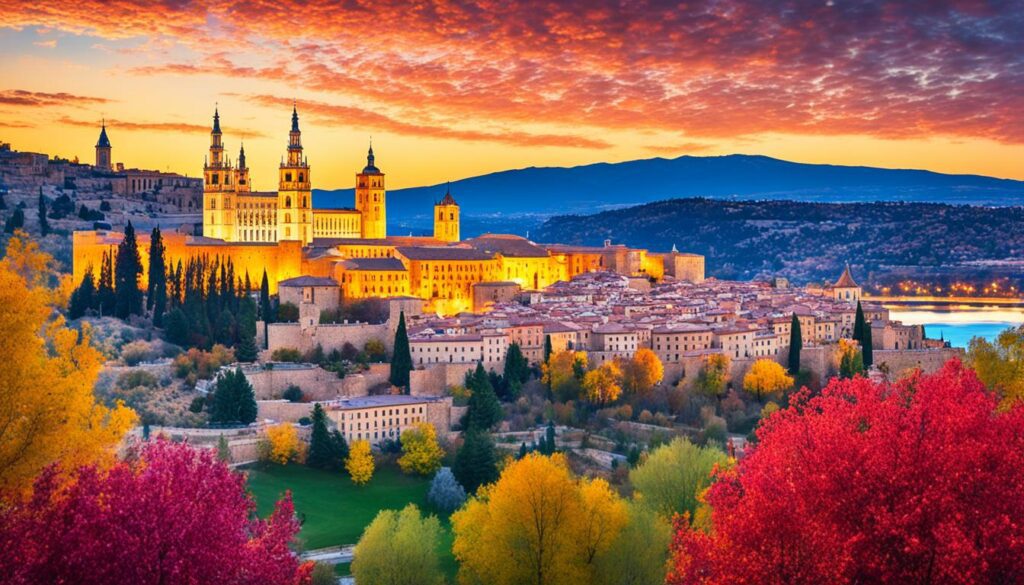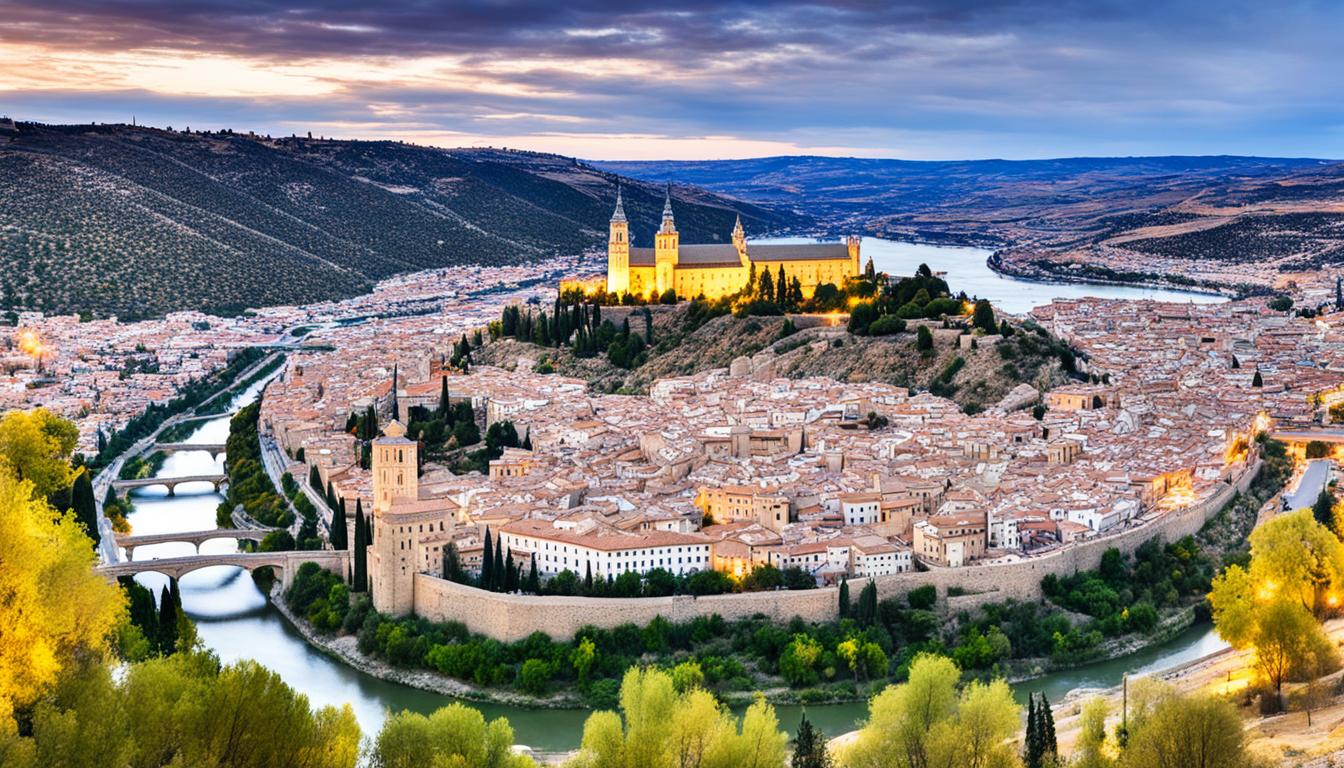Toledo sits in the heart of Spain, offering a peek into a rich cultural past. It’s on a hill, looking over the plains, and is a UNESCO World Heritage site. The city’s old buildings, ancient walls, and narrow streets tell stories of Christian, Muslim, and Jewish cultures blending for centuries.
The historic center of Toledo was named a UNESCO World Heritage site in 1986. It’s a mix of architectural styles, like Gothic cathedrals, Mudéjar synagogues, and old mosques. Famous artist El Greco lived and worked here in the 16th century, leaving a big impact on Toledo’s art scene.
Key Takeaways
- Toledo, Spain, is a UNESCO World Heritage site known for its rich cultural heritage and diverse architectural styles.
- The city’s historic center showcases a remarkable fusion of Christian, Muslim, and Jewish influences, reflecting its multifaceted past.
- Toledo’s cultural legacy is further enhanced by its association with renowned artists like the famous painter El Greco.
- Visitors can immerse themselves in Toledo’s captivating history and explore its breathtaking medieval landmarks, from the majestic Toledo Cathedral to the iconic Alcázar fortress.
- The city’s unique blend of art, architecture, and traditions makes it a must-visit destination for travelers seeking to discover Spain’s rich cultural heritage.
The City of Three Cultures
Toledo, Spain, is famous for being the “City of Three Cultures.” It’s a place where Christian, Muslim, and Jewish communities lived together. This has left a lasting impact on its buildings, traditions, and culture.
Exploring Toledo’s Multicultural Legacy
Toledo’s history is seen in its medieval buildings. You’ll find mosques, synagogues, and churches that show how these three faiths lived together. The Cathedral of Saint Mary of Toledo is a huge Gothic church, the second-biggest in Spain.
The Jewish Quarter may not have working synagogues anymore, but it still draws visitors with its narrow streets and historic sites. Places like the Synagogue of El Transito and the Santa María la Blanca synagogue are must-sees.
UNESCO World Heritage Site
Toledo’s historic center was named a UNESCO World Heritage Site in 1986. This honor highlights Toledo’s rich cultural and architectural history. It tells the story of its past, from the Visigothic Kingdom to the Christian and Moorish battles, and even Charles V’s rule.
Today, Toledo keeps its diverse heritage alive. It celebrates traditional festivals and crafts like Damasquinado jewelry and marzipan. The city also shows off its Mudejar-style architecture, a mix of Visigoth and Islamic art.
Architectural Wonders of Toledo
Toledo’s cityscape is a mix of architectural styles that show its rich cultural history. The Mudejar style stands out, thanks to Moorish craftsmen’s work in the area.
Mudejar Style: Blending Christian and Islamic Influences
The Mudejar style is known for its detailed brickwork, stone decorations, and geometric patterns. This is best seen in the beautiful Santo Tomé Church. It combines Christian and Islamic styles in a way that looks amazing and feels right for Toledo.
Gothic Masterpiece: The Toledo Cathedral
The Toledo Cathedral is a Gothic gem that wows with its flying buttresses, stained glass, and rich inside. It started in the 13th century and took 250 years to finish. This shows Toledo’s dedication to keeping its cultural past alive.
The Alcázar of Toledo also shows the city’s mix of styles, with Renaissance and military touches. It was once the Spanish royal home and now hosts the Army Museum. This lets visitors see Toledo’s military past.
“Toledo is a city that has been shaped by the coexistence of Christian, Muslim, and Jewish cultures, and this is reflected in its stunning architecture.”
Toledo’s architecture, from Mudejar churches to the Gothic cathedral, shows its lasting cultural impact. It mixes different styles into a beautiful and cohesive whole.
toledo spain cultural heritage
Toledo, a city in central Spain, is known for its deep cultural heritage. It sits by the Tagus River and has been a place where Jewish, Muslim, and Christian cultures blended. This mix is still felt in its historic streets and landmarks.
Remnants of Jewish, Muslim, and Christian Coexistence
Toledo’s old layout and many historic buildings show its past as a center of religious and intellectual cooperation. Places like the Synagogue of Santa María la Blanca and the Mosque of Cristo de la Luz remind us of the toledo jewish muslim christian coexistence.
By visiting these sites, you can dive into the toledo spain cultural heritage. Each building shows the unique styles and traditions of the communities that lived together in Toledo.
“Toledo is a living museum, where the past and present coexist in perfect harmony, offering visitors a unique glimpse into the city’s captivating cultural heritage.”
Toledo’s mix of religions and architecture shows how well toledo jewish muslim christian coexistence worked in the past. As a UNESCO World Heritage Site, Toledo draws travelers worldwide. It invites them to explore its toledo spain cultural heritage.
Gastronomic Delights of Toledo
Toledo is a city in central Spain that’s full of culture and great food. It’s a place where history and taste come together. The city’s food reflects the mix of Moorish, Jewish, and Christian traditions over the years.
A must-try dish in Toledo is the carcamusas, a tasty stew with lamb, veggies, and spices. It comes from the Moorish times, showing the city’s diverse past. Don’t miss the Toledan marzipan, a sweet almond treat that’s been loved since the Middle Ages.
Toledan chefs are proud of their game dishes, like partridge. They use the local wildlife in their cooking. The pisto manchego, a vegetable dish, also shows off the area’s rich produce and the creativity of local cooks.
| Traditional Dish | Description | Cultural Influence |
|---|---|---|
| Carcamusas | A hearty stew made with lamb, vegetables, and aromatic spices | Moorish |
| Toledan Marzipan | A sweet confection made from almonds, a cherished delicacy since the Middle Ages | Jewish and Moorish |
| Partridge Dishes | Game dishes featuring the abundant local partridge, showcasing the skill of Toledan chefs | Christian and regional |
| Pisto Manchego | A traditional vegetable-based dish similar to ratatouille, highlighting the region’s natural resources | Christian and regional |
Toledo’s food is a journey through its rich history. It invites visitors to taste the toledo spain cuisine, toledo gastronomy, and toledo traditional dishes. It’s a flavorful way to experience the city’s culture.

Local Crafts and Traditions
Toledo, Spain, is famous for its long-standing tradition of local craftsmanship. These traditions have been passed down for generations. The city is known for its damascene metalwork and sword-making. Artisans in Toledo keep these skills alive, keeping the city’s cultural heritage alive.
Damascene Metalwork and Sword-Making
The art of damascene metalwork is a key tradition in Toledo. It involves putting gold or silver into steel or other metals. This technique, from Arabic origins, is now a skill of Toledo’s artisans. They make beautiful decorative items and accessories that many people want.
Toledo has a long history of making swords, going back to the Roman times. The city’s swords and blades are known for their quality and craftsmanship. Today, local workshops still make these iconic weapons, loved for their beauty and use.
Marzipan and Convent Sweets
Toledo is also known for its sweets, especially marzipan. This almond-based treat has been made in Toledo for centuries. The city’s convents are famous for their traditional sweets, each with its own special recipe and taste.
Toledo’s crafts, from damascene metalwork to sword-making and sweets, show the city’s deep cultural roots. They highlight the lasting skills of Toledo’s artisans.
Exploring Toledo’s Historic Quarters
Walking through Toledo’s streets feels like going back in time. Each historic quarter shows a different part of the city’s history. The Jewish Quarter is a key spot. It has the Synagogue of El Tránsito and the Synagogue of Santa María la Blanca. These places connect us to Toledo’s toledo jewish quarter and its history of learning.
The Alcázar and Military Legacy
The Alcázar fortress is a key part of Toledo’s toledo military history. It goes back to the Roman times. Now, it’s an Army Museum, showing off Toledo’s military past.
| Landmark | Significance |
|---|---|
| Synagogue of El Tránsito | Well-preserved synagogue that reflects toledo jewish quarter culture and history |
| Synagogue of Santa María la Blanca | Another important toledo synagogues that bears witness to Toledo’s Jewish heritage |
| Alcázar of Toledo | Fortress with Roman origins, showcasing Toledo’s toledo military history |
Toledo’s historic areas, architecture, and culture make it a great place to visit. It’s perfect for those who love history and want to dive into Spain’s past.
The Corpus Christi Festivities
Toledo, Spain, hosts a major cultural event every year, the Feast of Corpus Christi. This tradition goes back to the 13th century. It shows the city’s deep religious roots and lively culture.
The streets of Toledo get decorated for this event. A big procession with religious figures, city leaders, and traditional characters like giants moves through the city. The main event is the Monstrance of Arfe procession, a key part of Toledo’s Catholic history.
The Monstrance of Arfe was made from 1515 to 1523. It’s 309.5 meters tall and is covered in gold-plated silver. It has a Gothic design with six pillars and is held up by four silver angels. A gold-plated silver cross with pearls and emeralds sits at the top.
The toledo corpus christi festival draws big crowds. People fill the streets, balconies, and squares. The day before Corpus day, there’s a parade with the Tarasque, Giants, and music. The streets are filled with the smell of lavender, rosemary, and thyme, making everything feel festive.
The toledo religious festivals are very important to locals and visitors. They let people see Toledo’s rich culture and its strong tradition.
“The Corpus Christi celebration in Toledo is a true testament to the city’s enduring faith and cultural identity. It is a remarkable display of devotion, tradition, and community spirit.”
Best Time to Visit Toledo
Planning a trip to Toledo, Spain? The best times are spring (March to May) or autumn (September to November). These seasons have mild weather. This lets visitors enjoy the city’s sights and events without the crowds.
In spring, Toledo’s weather is nice, with temperatures from 45°F to 65°F. It’s great for walking around the historic areas and seeing the beautiful buildings. The city comes alive with festivals and the greenery adds to the beauty.
Autumn in Toledo is also lovely, with temperatures like spring’s. It’s a quiet time, perfect for diving into the city’s culture without the summer rush.
| Season | Temperature Range | Precipitation |
|---|---|---|
| Spring (March-May) | 45°F to 65°F (7°C to 18°C) | 9-12 inches (230-300 mm) |
| Summer (June-August) | 70°F to 85°F (21°C to 29°C) | 8-10 inches (200-250 mm) |
| Autumn (September-November) | 45°F to 65°F (7°C to 18°C) | 6-8 inches (150-200 mm) |
| Winter (December-February) | 25°F to 40°F (-4°C to 4°C) | 12-18 inches (300-450 mm) of snowfall |
Summer in Toledo is hot, with temperatures up to 85°F. It’s the busiest time, with more people and higher prices. For a quieter visit, spring and fall are better.
Winter brings a lot of snow, turning Toledo into a winter wonderland. But it’s cold, with temperatures from 25°F to 40°F. It might be hard to enjoy the outdoors for long.
Toledo is great to visit any season. It’s full of history and culture. It’s a top spot for travelers wanting to explore Spain’s heritage.

Getting to Toledo
Toledo is a city in the heart of Spain that’s easy to get to from Madrid. You can travel by car or train, and both ways are beautiful and easy.
By car, it’s a 50-minute drive from Madrid, about 45 miles (72 km). The roads wind through stunning countryside, making the trip fun.
For train lovers, Toledo is just 30 minutes away from Madrid by high-speed train. Tickets are $20 to $25 round-trip, making it a budget-friendly choice. The train ride lets you see beautiful views as you go.
Once you arrive in Toledo, walking around is the best way to see it. The narrow streets, old doors, and brick buildings are all part of the city’s charm. It’s perfect for getting lost and discovering new things.
| Mode of Transportation | Travel Time from Madrid | Distance from Madrid | Cost Range |
|---|---|---|---|
| Car | 50 minutes | 45 miles (72 km) | Varies based on vehicle and fuel costs |
| Train | 30 minutes (high-speed) | 70 kilometers | $20 – $25 (round-trip) |
| On Foot | N/A | N/A | Free |
Toledo is easy to get to and has many ways to travel. Whether you drive, take the train, or walk, the trip is memorable. It’s a great place to see history and beautiful buildings.
Conclusion
Toledo, Spain, is a city that shows how cultures can come together and thrive. It’s a UNESCO World Heritage Site that lets visitors dive into a mix of Christian, Muslim, and Jewish cultures. These influences have shaped its stunning buildings, art, and food over the years.
The Toledo Cathedral and the Jewish Quarter are just the start of what makes this city special. Every corner tells a story of how Toledo keeps its rich heritage alive. You can see the Mudejar-style buildings, try local foods, or see the Corpus Christi festivities. Toledo’s culture and charm will surely capture your heart.
Toledo’s story is one of strength and unity among different cultures. It has been touched by the Romans, Visigoths, and Moors. Visitors can see amazing architecture, meet the locals, and learn about the city’s past. Toledo shows what it means to live together as Jews, Muslims, and Christians.

